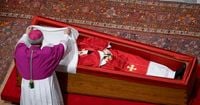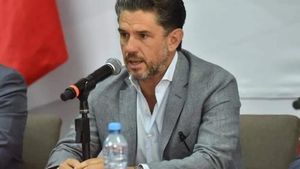On April 26, 2025, Rome is witnessing an extraordinary gathering as hundreds of thousands of people converge for the funeral of Pope Francis, who passed away on Easter Monday, April 21, at the age of 88. The ceremony is expected to attract around half a million attendees, including heads of state and government leaders from across the globe, marking a significant moment in the history of the Roman Catholic Church.
Pope Francis, who led the Catholic Church for twelve years, will be laid to rest in the Basilica of Santa Maria Maggiore, a departure from the tradition of interring popes in St. Peter's Basilica. This choice reflects his desire for a simpler, more humble burial, in line with his papacy characterized by mercy and a focus on the marginalized.
The funeral mass is set to commence at 10:00 AM local time on St. Peter's Square, where preparations have been extensive. The Italian Cardinal Giovanni Battista Re, dean of the College of Cardinals, will officiate the service. The closed coffin of Pope Francis will be placed prominently at the center of the dais, adorned with an open gospel book and a burning Easter candle, symbolizing the resurrection of Christ.
In the days leading up to the funeral, approximately 250,000 people visited St. Peter's Basilica to pay their respects. Many queued for hours, with waiting times reaching up to seven hours, to view the body of the beloved pontiff, whose health had been fragile in recent years.
Following the mass, the coffin will be transported through the streets of Rome in a solemn procession, covering a distance of about six kilometers. Notable landmarks along the route include the Piazza Venezia and the Colosseum. Unlike previous papal funerals, the public will not be able to join the procession but will be able to witness it from the streets.
Pope Francis's decision to be buried in Santa Maria Maggiore is significant. The basilica, which dates back to the fifth century, was a place of personal pilgrimage for him. His grave will be simple, made of Ligurian marble, and will bear only the inscription "Franciscus." He requested to be buried in the ground without elaborate decorations, emphasizing his humble approach to life and leadership.
Among the dignitaries expected to attend the funeral are U.S. President Donald Trump, French President Emmanuel Macron, British Prime Minister Keir Starmer, and Ukrainian President Volodymyr Zelensky, who received a warm welcome upon his arrival at the square. The guest list includes representatives from over 160 countries, reflecting the global impact of Pope Francis's leadership.
Security measures for the event are stringent, with the Italian Ministry of the Interior anticipating around 250,000 attendees. The airspace above the Vatican has been closed, and thousands of police officers, along with anti-terrorism units, are deployed to ensure safety during the proceedings.
In a poignant detail, Pope Francis's coffin was sealed on the evening of April 25, following a private ceremony led by Cardinal Kevin Farrell. Visitors were allowed to pay their last respects until 6 PM, after which coins minted during his papacy and an official record of his pontificate were placed inside the coffin.
As the world reflects on the legacy of Pope Francis, his funeral serves not only as a farewell but also as a moment for diplomatic discussions among world leaders. Many are expected to engage in crucial conversations during this unique gathering, highlighting the intersection of faith and global politics.
The funeral mass is set to last approximately 90 minutes, concluding around 11:30 AM. After the service, the Pope's body will be transported to Santa Maria Maggiore, where he will be laid to rest in a private ceremony.
The Novemdiales, a period of nine days of mourning and prayer for the soul of Pope Francis, will commence following his burial. This period will lead up to the conclave, where cardinals will gather to elect his successor, expected to begin within the next few weeks.
Pope Francis's papacy was notable for its emphasis on humility, compassion, and outreach to the marginalized. His passing marks the end of an era, and as the Catholic community and the world mourns, discussions about his legacy and the future of the Church are already underway.
In a time of transition, the question of who will succeed Pope Francis looms large. The conclave will soon gather to elect a new leader, and the legacy of Francis as the first South American pope and a champion of social justice will undoubtedly influence the direction of the Church moving forward.





